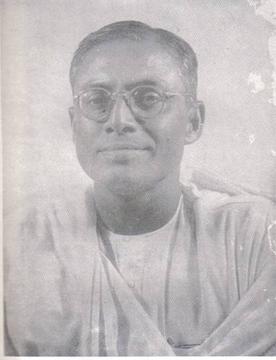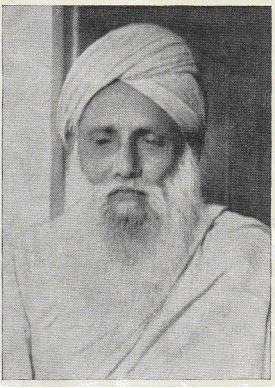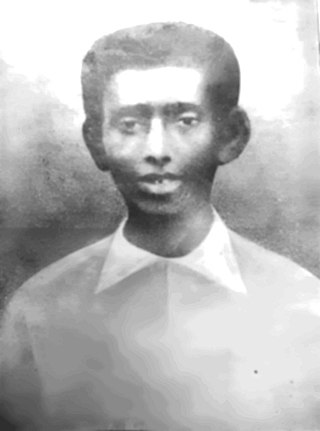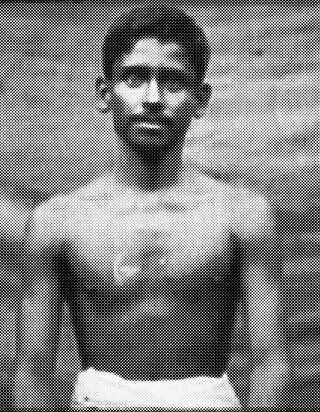
Bagha Jatin or Baghajatin, born Jatindranath Mukherjee ; 7 December 1879 – 10 September 1915) was an Indian independence activist.
Emperor vs Aurobindo Ghosh and others, colloquially referred to as the Alipore Bomb Case, the Muraripukur conspiracy, or the Manicktolla bomb conspiracy, was a criminal case held in India in 1908. The case saw the trial of a number of Indian nationalists of the Anushilan Samiti in Calcutta, under charges of "Waging war against the Government" of the British Raj. The trial was held at Alipore Sessions Court, Calcutta, between May 1908 and May 1909. The trial followed in the wake of the attempt on the life of Presidency Magistrate Douglas Kingsford in Muzaffarpur by Bengali nationalists Khudiram Bose and Prafulla Chaki in April 1908, which was recognised by the Bengal police as linked to attacks against the Raj in the preceding years, including attempts to derail the train carrying Lieutenant-Governor Sir Andrew Fraser in December 1907.

Anushilan Samiti was an Indian fitness club, which was actually used as an underground society for anti-British revolutionaries. In the first quarter of the 20th century it supported revolutionary violence as the means for ending British rule in India. The organisation arose from a conglomeration of local youth groups and gyms (akhara) in Bengal in 1902. It had two prominent, somewhat independent, arms in East and West Bengal, Dhaka Anushilan Samiti, and the Jugantar group.
The Revolutionary movement for Indian Independence was part of the Indian independence movement comprising the actions of violent underground revolutionary factions. Groups believing in armed revolution against the ruling British fall into this category, as opposed to the generally peaceful civil disobedience movement spearheaded by Mahatma Gandhi.
Jugantar or Yugantar was one of the two main secret revolutionary trends operating in Bengal for Indian independence. This association, like Anushilan Samiti, started in the guise of suburban fitness club. Several Jugantar members were arrested, hanged, or deported for life to the Cellular Jail in Andaman and many of them joined the Communist Consolidation in the Cellular Jail.

Barindra Kumar Ghosh or Barindra Ghosh, or, popularly, Barin Ghosh was an Indian revolutionary and journalist. He was one of the founding members of Jugantar Bengali weekly, a revolutionary outfit in Bengal. Barindra Ghosh was a younger brother of Sri Aurobindo.

Bhupendra Kumar Dutta was an Indian freedom fighter and a revolutionary who fought for Indian independence from British rule. In addition to his other specific contributions as a Jugantar leader, he holds the record of a hunger strike for 78 days in Bilaspur Jail in December 1917.

Jadu Gopal Mukherjee was a Bengali Indian revolutionary who, as the successor of Jatindranath Mukherjee or Bagha Jatin, led the Jugantar members to recognise and accept Gandhi's movement as the culmination of their own aspiration.

Shashibhushan Raychaudhuri, also known as Shashida, was a patriotic educationist connected with the radical revolutionary activities that had their origins in Bengal. He was the pioneer in what came to be known as the night-school movement, for building up a self-reliant society.

Panchanan Chakravarti was a Bengali Indian revolutionary, one of the creators of the Revolt group after the momentary unification of the Anushilan Samiti and the Jugantar in the 1920s. Friend of the poet Kazi Nazrul Islam, he was a close associate of Subhas Chandra Bose.

Bhavabhushan Mitra, or Bhaba Bhusan Mitter, alias Swami Satyananda Puri was a Bengali Indian freedom fighter and an influential social worker.

Atulkrishna Ghosh was an Indian revolutionary, member of the Anushilan Samiti, and a leader of the Jugantar movement involved in Hindu German Conspiracy during World War I.
Pandit Mokshada Charan Samadhyayi (1874–?) was a leading figure of the Jugantar movement.

Amarendranath Chatterjee was an Indian independence movement activist. In charge of raising funds for the Jugantar movement, his activities largely covered revolutionary centres in Bihar, Odisha and the United Provinces.
The first Christmas Day plot was a conspiracy made by the Indian revolutionary movement in 1909: during the year-ending holidays, the Governor of Bengal organised at his residence a ball in the presence of the Viceroy, the Commander-in-Chief and all the high-ranking officers and officials of the Capital (Calcutta). The 10th Jat Regiment was in charge of the security. Indoctrinated by Jatindranath Mukherjee, its soldiers decided to blow up the ballroom and take advantage of destroying the colonial Government. In keeping with his predecessor Otto von Klemm, a friend of Lokmanya Tilak, on 6 February 1910, M. Arsenyev, the Russian Consul-General, wrote to St Petersburg that it had been intended to "arouse in the country a general perturbation of minds and, thereby, afford the revolutionaries an opportunity to take the power in their hands." According to R. C. Majumdar, "The police had suspected nothing and it is hard to say what the outcome would have been had the soldiers not been betrayed by one of their comrades who informed the authorities about the impending coup".
The history of the Anushilan Samiti stretches from its beginning in 1902 to 1930. The Samiti began in the first decade of the 20th century in Calcutta as conglomeration of local youth groups and gyms(Akhra). However, its focus was both physical education and proposed moral development of its members. From its inception it sought to promote what it perceived as Indian values and to focus on Indian sports e.g. Lathi and Sword play. It also encouraged its members to study Indian history as well as those of European liberalism including the French Revolution, Russian Nihilism and Italian unification. Soon after its inception it became a radical organisation that sought to end British Raj in India through revolutionary violence. After World War I, it declined steadily as its members identified closely with leftist ideologies and with the Indian National Congress. It briefly rose to prominence in the late second and third decade, being involved in some notable incidents in Calcutta, Chittagong and in the United Provinces. The samiti dissolved into the Revolutionary Socialist Party in 1930.
The Rodda company arms heist took place on 26 August 1914 in Calcutta, British India. Members of the Jugantar faction of the Bengali revolutionary organisation Anushilan Samiti intercepted a shipment of Mauser Pistols and ammunition belonging to Messrs Rodda & co., a Calcutta gun dealer, while these were en route from the Customs house to the company's godown, and were able to make away with a portion the arms. The heist was a sensational incident, being described by The Statesman as the "Greatest daylight robbery". In the following years, the pistols and ammunitions were linked to almost all the incidences of nationalist struggles in Bengal. By 1922, the police had recovered most of the stolen arms.

Chittapriya Ray Chaudhuri was a Bengali revolutionary and member of the Indian independence movement. Martyred at the age of twenty years, Ray Chaudhuri, was born in the Khalia landlord family in the Madaripur subdivision of Faridpur district in undivided Bengal. His father, Panchanan Ray Chaudhuri, who passed the entrance examination in the first year of his introduction to Calcutta University, was a teacher and an honorary magistrate. Well-built, Chittapriya Ray Chaudhuri was known for his daredevilry.
Anarchism in Bangladesh has its roots in the ideas of the Bengali Renaissance and began to take influence as part of the revolutionary movement for Indian independence in Bengal. After a series of defeats of the revolutionary movement and the rise of state socialist ideas within the Bengali left-wing, anarchism went into a period of remission. This lasted until the 1990s, when anarchism again began to reemerge after the fracturing of the Communist Party of Bangladesh, which led to the rise of anarcho-syndicalism among the Bangladeshi workers' movement.

Biren Datta Gupta, was an unforgettable martyr of the Indian freedom movement. At an early age, he developed a keen interest in contemporary Indian politics and became actively involved in revolutionary activities. Birendranath was hanged in connection with the murder of Shamsul Alam, deputy superintendent of police, the chief investigating officer in the Alipore conspiracy case.









